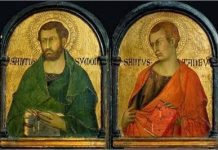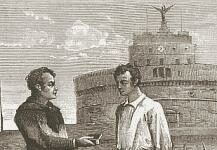Rose of Lima (+1617), whose birth name was Isabel, was called ‘Rose’ when a servant saw her face mystically transformed into the beautiful flower soon after she was born. Sure enough, Isabel-Rose would go on to become the first native-born canonized saint of the Americas, renowned even during her lifetime for her generosity and charity, flowing from a life of self-denial, asceticism and prayer. Although beautiful and desired, from the earliest age she renounced any thought of marriage, making a private vow of virginity, cutting her hair and smearing pepper on her face, so that she would appear less appealing to members of the less-fair sex. Her father forbade her entrance into the convent, so she remained in the lay-state, joining the third-order Dominicans in their spiritual work, helping the poor, selling the very fine needle-work she would make, itself the fruit of her discipline and focus.
When we read of her rather extreme penances – in imitation of her Dominican predecessor, Catherine of Siena – fasting three times a week, sleeping but two hours a night, and that on a bed covered in shards, which even she shuddered to lie down upon; wearing a silver crown of thorns – which she covered in roses, so no one would know; her many hours before the Blessed Sacrament, reducing her sleep so to spend more time in prayer…But we should see these as motivated by the love of God, and not from any morbidity or masochism. Even though they seemed strange and repugnant, to the world, even to many Catholics, perhaps even to many of us, for Rose they were not a denial of the goodness of these natural things, but rather an affirmation thereof. For their goodness derives from their source, He Who is all good. And to sacrifice them to that same God – literally, to ‘make them holy’ – was only so that she might leapfrog over them, to attain to God Himself. She sought to remove all that stood in the way of complete devotion and self-gift to the One Who has given all to us. As Saint Paul confessed: Indeed I count everything as loss because of the surpassing worth of knowing Christ Jesus my Lord. For his sake I have suffered the loss of all things, and count them as refuse, in order that I may gain Christ (Phli 3:8)
And God did not stint in his reciprocity, favouring Rose with a life of great virtue, patience, charity, along with ecstasies, visions, miracles and heavenly delights. Foretelling her own death, she entered heaven at the tender age of 31, anno Domini 1617, just as, across the ocean, Galileo was in the midst of his investigation of the cosmological heavens, and to the north, and eight years before Jean de Brebeuf began his missionary labours amongst the Hurons here in Canada. God has all things in hand, but we usually only see that well after the fact.
Rose was canonized sixty years later – a short span in those days – April 12th , 1671 by Pope Clement X. She is the patron saint of embroiderers, the Philippines and, of course, Peru, where she appears on their highest currency, the 200 soles bill, ironic for one who never owned any money, nor anything much at all. For all she had, she gave to God, something we should ponder in this age of immersion and addiction in all the ‘world’ has to offer.
Saint Rose of Lima, oren pro nosostros!












